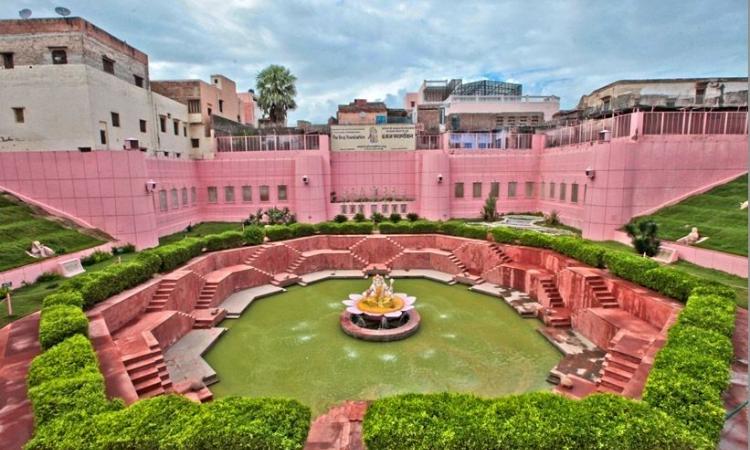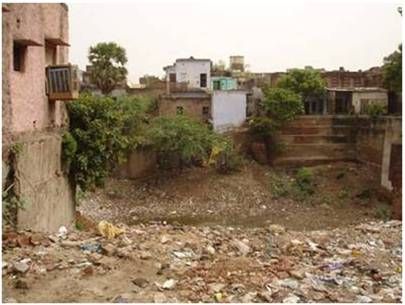
Vrindavan, the small dusty twin town of Mathura in Uttar Pradesh, has a special place in the Hindu mythology. This is where Lord Krishna is believed to have spent most of his childhood and adolescence. The river Yamuna straddles through the town, a hot destination for thousands of devotees lining up for a dip in it every day. The place is also known for the rich saturated colours and messy revelry during “lathmar” holi where people hit each other with sticks.
As one saunters through its narrow lanes, one can see it bursting at the seams with its numerous ashrams and temples dedicated to Radha and Krishna. The town, infamous for the social restrictions on widows, is in shambles. Its garbage, open sewers, waste mismanagement and the poor state of forests and water bodies make it an unhealthy place to live. Housing colonies have come up in its outer reaches while a transport bridge over the river Yamuna has added to the vehicular traffic and ecological woes.
Kunds dotted these tracts at one time
The town is historically known for its lush green forests, verdant sacred groves and serene hills. Most of the sacred groves around the area, except Kokilavan and Gahvarvan, have now turned into tropical thorny scrub forests.
Man-made small water bodies known as kunds dating back to the 5th to the 15th century served as important sources of freshwater in this region, culturally known as Braj. “The significance of kunds was huge and went beyond the social and the spiritual. There were more than 1000 kunds in Braj, all of which were sources of fresh water in the past. The water was used for multiple purposes such as irrigation, domestic use, drinking, etc. Due to rapid urbanisation, a lack of maintenance and prolonged negligence in the last 200 years, 80 percent of the kunds became silted up and were relegated to gradual extinction,” says Rajnish Kapur, secretary, The Braj Foundation, a non-profit organisation, established to restore and revitalise the environmental and cultural heritage of Braj.
“These systems (kunds) have a special bearing on the ecology and the culture of the region where they evolved,” says Kapur. “Nowhere is this significance of water more evident than in the beliefs of the Brajbhoomi where river Yamuna and hundreds of kunds are integral to the Krishna legend. If conquering the Kalia serpent is an ancient precursor to saving the Yamuna from pollution and environmental degradation, the meeting of Krishna and the gopis near a water body is representative of the importance of such sites in the socio-cultural fabric of the society,” he adds.
As per a study by A. K. Saha et al of the Indian Institute of Technology, Roorkee published in the South Asian Journal of Tourism and Heritage (2010), the water bodies here in the Indo-Gangetic plains are unique as they were built in the lower and mid-slope positions so as to capture the runoff (flowing rainwater) easily.
“In order to protect the water bodies, pucca ghats were built using sand, stones, lime, etc. The maintenance of the ghats is also important without which the huge runoff generated from heavy downpour may wash away the structure. In order to prevent the ghats from breakage, spillways were built at a certain height so that water can be stored to an optimum limit for use during the rest of the year without any damage to the water bodies. The excess water is drained off,” writes Saha.
In almost all villages, such structures were planned and constructed by the people. The silt in the water bodies was dug up by farmers before the monsoons and carts were used to transport them to the fields where the silt was applied for improving crop yields. As per the study by Saha et al, there were about 300 kunds existing in 2010. Most of these have been surveyed by The Braj Foundation. The survey included the geographic location, size, water depth and siltation status of the kunds.
There were two prominent kunds in Vrindavan--Rudra kund and Brahma kund-- both of which had silted up in the last 50 to 100 years due to long-standing neglect, need for desilting, weed removal, minor repairs and maintenance of the water body and the ghats. The maximum water level in both of them is poor at less than a metre. A lot of these water bodies were lost to urbanisation or were encroached upon.
Brahma kund in bad shape
Brahma kund, located at the heart of Vrindavan, is a revered site and is considered to be the sanctum sanctorum of the town. “Two serious attempts were made to restore the kund in the past 500 years. In the 1600s, Orchha’s (Jhansi) ruler Raja Bir Singh Deo was the first to undertake its renovation. But by 1882, the kund was reported to be in ruins. This finds mention in the book, Mathura: A District Memoir by the then British district collector of Mathura F. S. Growse,” says Kapur.

“The Brahma kund is now in ruins and parts of the stone kiosks at its four corners have fallen. The fallen parts have been occupied by vagrants, who have closed up the arches with mud walls and converted them into dwelling places,” the memoir reads. “Growse had begun to effect a clearance and make arrangements for the kund’s repair when he was transferred which put an immediate stop to his efforts and all similar improvements he was undertaking in the area,” says Kapur.
“Despite such a glorious history, the Brahma kund was in an abject state of neglect. It had become very filthy, with a strong foul smell, as it was being used as a dump site for the local municipal garbage carts for several decades. Despite the existence of many Sampradayas, famous Acharyas and Bhagwat Katha Vachaks in Vrindavan, with huge followings of wealthy disciples, it is surprising that no one came forward to restore this precious heritage,” says Kapur.
Restoring the water bodies
“Initially, the villagers were apprehensive about The Braj Foundation’s intentions because they have been repeatedly cheated by several agencies in the past. Once they saw our passion and success of our projects, they started making a beeline to our field office at Vrindavan, to take up the cause of their village on top priority,” says Vineet Narain, an anti-corruption crusader and investigative journalist who set up the organisation way back in 2002.
Identifying and systematically documenting these forgotten kunds, including the historical ones, young IITians associated with the Braj Foundation started a mammoth task that many officials and government agencies had shied away from. Beginning in 2002, the NGO, braving initial hesitation of villagers and opposition from vested interests, started the process of restoring ancient kunds which continues with the same zeal till date.
When Braj Foundation undertook the restoration of the Brahma kund, it had to face many hurdles. The Brahma kund had been encroached upon from all four sides and one of the ghats was converted to a house. Vested interests were at play with the intent to construct houses over it. The community did not show any interest during the 30 months of restoration.
Once the sites were identified and marked, earthmovers dug till the water level was reached. The silt thus excavated was used for landscaping the surroundings of the kund. “Once the kund was desilted, the natural aquifers opened up filling it with naturally sweet water. If we go by the report by the Central Ground Water Board (2003), the water must be from the shallow unconfined aquifer that lies between 30-80 m,” says Kapur.
Octagonal ghats with steps were built and sculptures of fish and turtles were made on the steps to give it a natural look. An 8-ft-high Brahma sitting over the 13-ft-wide lotus flower has been installed in the centre of the kund. Each petal of the lotus throws the pond water back into the kund. This is to ensure regular oxygenation of water. Piramal Foundation, the philanthropic arm of the Piramal group, financially supported the restoration and the upkeep of the kund.
“The Braj Foundation has so far revived over 50 kunds and has created an additional water retention capacity of five lakh cubic metres,” says Kapur. Narain gives credit to his dedicated team which has been slogging away for the past 15 years, facing hostile weather conditions, to accomplish the targets set by the foundation. “Due to the limitation of funds, we cannot scale up our activities. Hence, we have to prioritise the kunds on the basis of their viability and historical significance,” adds Narain.
“For us, Krishna continues to be present not merely in the grand temples built to attract pilgrims and tourists alike, but in the groves and water bodies of this holy land. It is these water bodies and their adjoining green patches that reiterate the fact that water is a finite source that needs to be protected--the way Krishna had nurtured these thousands of years ago,” says Mansukh Singh of the Foundation.
/articles/saving-kunds-vrindavan